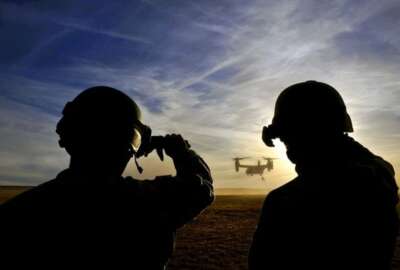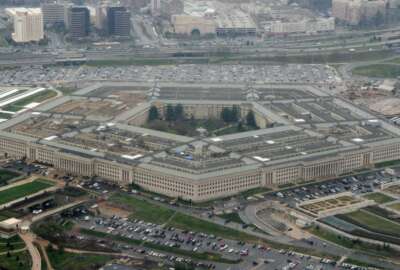Pentagon releases classified strategy for countering drones
The new strategy is an an acknowledgment of the systems’ growing impact on modern warfare.
Defense Secretary Lloyd Austin has signed a classified strategy that aims to create a unified and comprehensive approach across the Defense Department to countering drones, an acknowledgment of the systems’ growing impact on modern warfare.
While the strategy’s details will remain classified, Pentagon Press Secretary Maj. Gen. Pat Ryder told reporters Thursday that the document focuses on ensuring the department’s preparedness to conduct counter-unmanned systems operations, establishing an incident response framework, as well as tracking unmanned systems and counter-UAS equipment to stay ahead of emerging threats.
“Unmanned systems have the potential to pose both an urgent and enduring threat to the U.S personnel, facilities and assets overseas and increasingly in the U.S. homeland. As you know, the threats presented by these systems are changing how wars are fought. With this singular strategy for countering unmanned systems, in conjunction with other major DoD initiatives, the DoD is orienting around a common understanding of the challenge and a comprehensive approach to addressing it,” said Ryder.
The strategy comes as the Pentagon grapples with drone incursions both overseas and at home — for over a year, Houthi rebels have been using small drones to attack ships in the Red Sea, and in Ukraine, drones have completely changed the character of war.
Last month, unidentified drones were spotted over four bases in the U.K. where U.S. military operations are conducted. And last December, a number of unidentified drones were seen over Langley Air Force Base on Virginia’s shoreline for 17 days.
The strategy builds on a number of high-level DoD initiatives, including the efforts led by the Joint Counter-Small UAS office, which was stood up in 2020 to synchronize counter-UAS development, doctrine and training across the force.
The strategy also follows the Replicator 2 effort, which will address countering small drones at military installations across the globe — Defense Secretary Lloyd Austin announced the initiative in September in a force-wide memo.
Broadly, the document lays out five “strategic ways,” which provide specific directions to guide the implementation of counter-drone measures.
According to the factsheet, those include:
- Deepening the department’s understanding and awareness of unmanned trends and threats;
- Disrupting and degrading unplanned systems threat networks;
- Ensuring counter-drone measures are integrated into doctrine, training, organizational structure and policy;
- Prioritizing rapid development and deployment of counter-drone technologies at scale;
- And ensuring that counter-unmanned systems play a key role in the department’s future force development and design efforts.
The strategy, the factsheet notes, requires a “campaign mindset” — the Pentagon pledged to work with interagency partners and Congress to “align authorities, resources, and approaches, and leverage the private sector and broader defense innovation ecosystem to address unmanned systems technological advancements,
“This strategy marks a critical next step in the Department of Defense’s efforts to counter unmanned systems, but much work lies ahead. The Department will establish clear metrics and measures of effectiveness to track progress in achieving outcomes,” the strategy says. “Although the rapidly evolving nature of the threats posed by adversary use of unmanned systems
means that the Department will need to continually reassess our efforts, this strategy sets a foundation for action to meet this challenge.”
Copyright © 2025 Federal News Network. All rights reserved. This website is not intended for users located within the European Economic Area.







